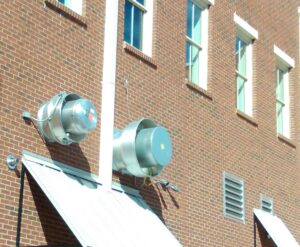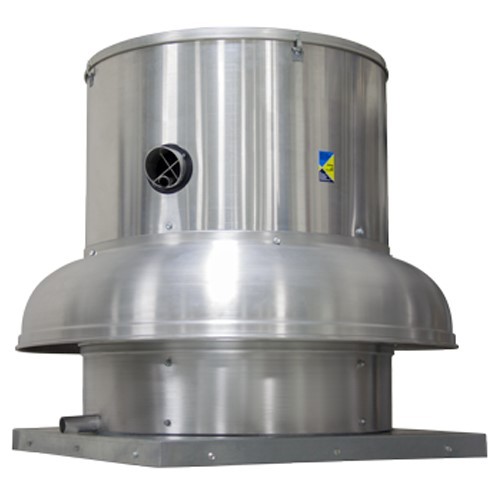
When purchasing a new exhaust fan, one of the most basic decisions you’ll make is whether to buy a downblast exhaust fan or an upblast exhaust fan. Knowing the differences between the way these two fans work and what applications they are best suited for will help you determine which fan is right for your needs and help you avoid potential problems that can be caused by purchasing and installing the wrong exhaust fan. The experts at HoodFilters.com are here to help you learn what you need to know to make an educated decision when you’re faced with choosing between an upblast exhaust fan or a downblast exhaust fan.
Exhaust fans are essential to good ventilation.

Exhaust fans do a very important job and play a critical role in the ventilation of any building. In restaurants and commercial kitchen ventilation systems, they are particularly helpful in getting rid of everything from stale air, foul cooking odors, and excessive moisture or heat to harmful smoke particulates and grease laden vapors. By pulling out contaminated air, exhaust fans improve indoor air quality and help create a cleaner more comfortable environment for employees and patrons alike. By pulling out moisture, they help keep buildings safe from mold growth.
How do exhaust fans work?
Exhaust fans work by using a motor that turns the blades of a fan that then pulls heat, grease vapors, smoke, moisture or contaminated air through duct work, then venting that bad air to the outdoors. Exhaust fans generally operate using electricity. The two typical types are direct drive and belt drive. Belt driven fans have at least one belt that connects the motor to the fan. In a direct drive fan, the fan motor is connected to the fan blades by either a shaft or fan axle which causes the fan blades to rotate at the exact same speed as the motor is rotating. To learn more about the differences between the two, check out this article for information on the pros and cons of direct and belt drive exhaust fans.

Two Types of Exhaust Fans
There are two main types of exhaust fans available for use in commercial kitchens and restaurants: upblast fan and downblast exhaust fan. Perhaps you have already guessed what the most obvious difference is between the two, based solely on their names. While an upblast fan exhausts or blows air up and away from the fan, a downblast fan actually blows air back down towards the fan base after pulling it up through the duct work.

DOWNBLAST FAN
That may be the most noticeable difference, but the most important difference isn’t nearly as visible. If you were to look inside of each fan, you would see that upblast fans have a sealed motor compartment while downblast fans do not. The reason that this is important is because the sealed compartment protects the motor in an upblast exhaust fan from things like heat, grease, and moisture. Downblast fan motors, however, are not protected in this way.
You may note the design looks a bit like a mushroom. This is to help protect the motor from precipitation and bad weather. But there is no protection built in for guarding the motor from heat and moisture-laden air that be pulled up through the ducts. And because of this, there are two distinct applications for each type of fan.
Which exhaust fan is right for my application?

DOWNBLAST FAN
When you are looking for the right exhaust fan, it is fairly simple to determine whether you need an upblast or downblast exaust fan. You’ll need to know what type of ventilation system the exhaust fan is going to be connected to and what type of area it will be exhausting air from.
Will it be exhausting air from a dining room, from a warehouse, from a commercial kitchen? Is it going to be connected to a vent hood that is located over cooking appliances or a commercial dishwasher? If your fan needs to exhaust air connected to a hood that is over any type of cooking appliance or dishwasher, you’ll need an upblast exhaust fan.
In addition to having a motor that is protected from smoke and grease contaminants as well as heat and moisture, upblast exhaust fans are designed to actually capture and drain grease so that it does not drain onto your roof or drip back into your ducts.

UPBLAST FAN
Grease on your roof can lead to several problems including fire hazards and structural damage and grease and creosote buildup in your ducts can put you at risk for extremely dangerous duct fires that can quickly spread throughout an entire building in just seconds.
It’s probably pretty clear why you should never use a downblast fan to exhaust grease or smoke. But somewhere along the line, someone may have told you that you can install a downblast fan with a Type 2 hood to exhaust heat and moisture. If so, they were wrong.
It doesn’t matter if the hood is a Type 1 or Type 2 hood, and it doesn’t matter if there is absolutely no grease or smoke being exhausted. Even if there is only heat or moisture, you will need an upblast exhaust fan to do the job. If you use a downblast fan for anything other than stale air and odors, you put your ventilation system at risk by exposing your fan motor to possible damage.
Watch this short video comparing downblast and upblast restaurant exhaust fans too see more about the difference.
Making sure that you have the right equipment installed in your commercial kitchen will help ensure your ventilation system runs efficiently and maintains a safe environment. Downblast fans are designed only for general ventilation and they should never be used with Type 1 grease hoods, Type 2 condensate hoods, or any other cooking equipment. Almost any commercial kitchen ventilation application is going to require an upblast exhaust fan.
If you need help selecting a fan or have questions about the differences between downblast and upblast exhaust fans, just give us a call at 877.394.9731, send an email to customerservice@hoodfilters.com, or visit us online. Our product specialists are always happy to help!
